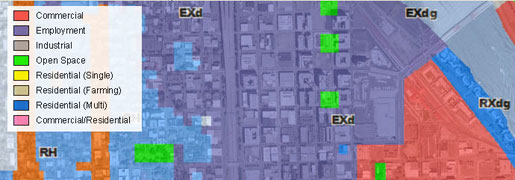So You've Been Using Google Earth and Now You Want Do More
Sure, Google Earth is really cool. Fun, easy to use, easy to pick up and show your friends, you can use your Mac or your Windows machine. But it's a really limited tool for representing geospatial data that YOU created. If you want to show some points on a map that's fine and that's easily done with the Google Earth Plus version, but if you want to make the size of the points change for a certain attribute, you need a more robust tool and GIS software may be your answer.
At Vassar, we have a couple of computer lab locations that have the GIS software ESRI's ArcGIS installed on the machines, the GIS lab in Ely Hall and the Scientific Visualization Lab in Mudd Chemistry. ArcGIS is only available for Windows machines. We do not have a site license for this software, but that should not limit your access to using this geospatial tool too much.
We also have the advanced Google Earth Pro available only in the GIS lab. This is discussed in more detail below.
Geocoding for Free and Viewing in Google Earth

Batch Geocode is terrific, easy to use and free. Geocoding in ArcGIS is not pleasant. Success rates hit a high of about 70 percent, in my experience. Batch Geocode is highly accurate and pretty fast.
Your address file must be in tab-delimited text format.
Though Batch Geocode is freely available, if you find yourself using this great tool, please contribute.
Because Batch Geocode gives you a longitude and latitude, you can easily bring your new table back into ArcMap.
Exporting Shapefiles From ArcGIS to KML Format
Using ESRI's ArcGIS , again in specialized computer labs around campus, you can export a shapefile and bring it into Google Earth.
Here's the ESRI link to the that nice ArcScript for ArcMap 9.x. You can export a shapefile into a KML file for Google Earth viewing right from ArcMap. I'm giving the ESRI link so they can keep track of the downloads. They like that.

The icon in ArcGIS loks like a little Google Earth icon, shpown below a little larger than in reality.
With Google Earth Pro You Can Pretend to Have a GIS
You can import a variety of data files into Google Earth Pro that makes it seem a little GIS-like. But don't be fooled. Our GIS lab in Ely Hall has Google Earth Pro loaded on all the machines.
Here's what you can import or open in Google Earth Pro:

What is the Difference Between Google Earth free, Google Earth Plus and Google Earth Pro?
This is puled right from the Google Earth web pages. Google Earth for All "combines the power of Google Search with satellite imagery, maps, terrain and 3D buildings to put the world's geographic information at your fingertips." FLY! SEARCH! TILT! ROTATE!
Google Earth Plus is $20 ad with it you can "intensify your Google Earth experience with these added features:
- Enhanced network access for faster performance
- Real-time GPS tracking and track/waypoint import –- for upload of data from select GPS devices (Verified support for Magellan and Garmin devices only and Does not support export of tracks or waypoints to a GPS )
- Greater-than-screen-resolution printing – for impressive hardcopies
- Customer support via email
- Spreadsheet importer – to import locations from .CSV files
- Import 2,500 locations by address or geospatial coordinates from a spreadsheet.
- You get additional measurement tools (square feet, mile, acreage, radius and so on)
- Export high-resolution images up to 11" x 17"
- You create your own compressed movies of the zooms and virtual tours you take in Google Earth
Google Earth Pro is $400 "With Google Earth Pro, it’s easy to research locations and present your discoveries. In just a few clicks, you can import site plans, property lists or client sites and share the view with your client or colleague." But what they mean is that you can import shapefiles (i.e., the native files format for ESRI's GIS software) or .tab files (i.e., native file format for MapInfo GIS files). That's cool.
What else can you do?







No comments:
Post a Comment